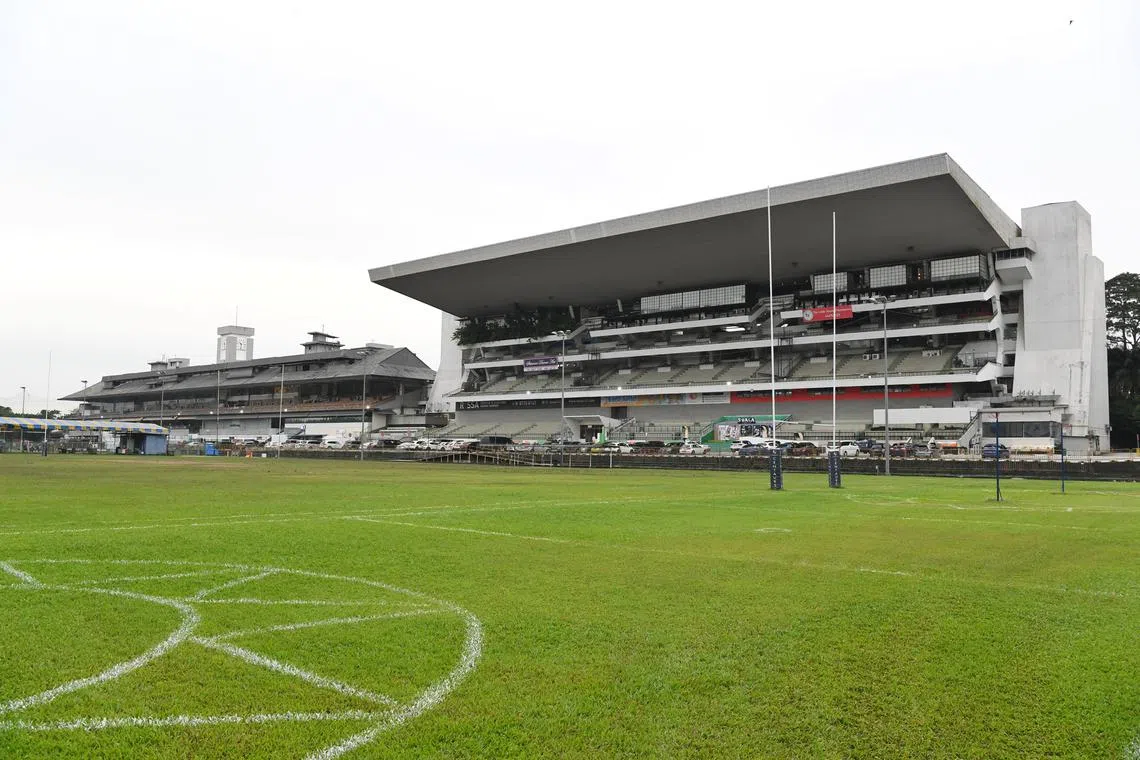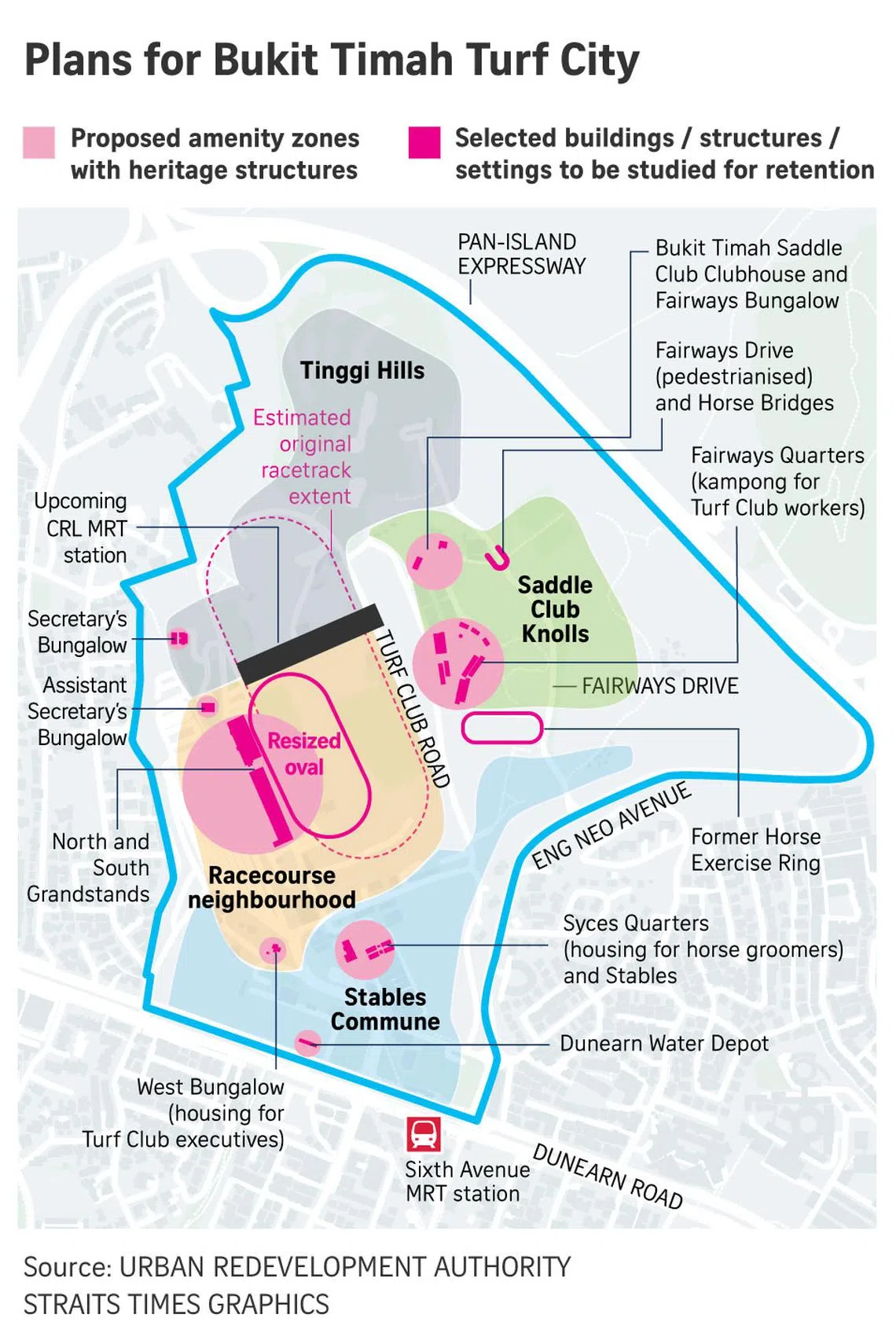New HDB flats prevent further entrenchment of Bukit Timah as private home enclave: Experts
Sign up now: Get ST's newsletters delivered to your inbox

Between 15,000 and 20,000 homes will be built on the 176ha site over the next two to three decades.
PHOTO: ST FILE
Follow topic:
SINGAPORE – The introduction of new public housing in Bukit Timah for the first time in about 40 years is a significant move that could help prevent the further entrenchment of the area as a private residential enclave, said urban studies scholars.
Their comments follow an announcement by Minister for National Development Desmond Lee on May 23 that a mix of public and private homes will be developed on the grounds of the former Bukit Timah Turf City.
Between 15,000 and 20,000 homes will be built on the 176ha site over the next two to three decades.
A spokesperson for the Urban Redevelopment Authority (URA) said agencies are still working on the detailed plans for the site, including the proportion of public and private homes.
Dr Harvey Neo, a professorial research fellow at the Lee Kuan Yew Centre for Innovative Cities, said that if the Government is truly sincere in “unpriming” the image of areas like Bukit Timah, the majority of the planned homes should be public flats.
Comparing Turf City with Tengah, which is slated to have 42,000 homes, about 70 per cent of them public flats, Dr Neo said a clear sign that the Government wants to have greater diversity would be if it set aside at least 80 per cent of the upcoming units on the former racecourse site for the public.
But this may still not be enough to change public perceptions of Bukit Timah, given that Turf City is a small part of a district with a great concentration of private homes, he said.
“We already have had limited public housing around Toh Yi Drive for years but that has not changed the perception of Bukit Timah,” he said.
Dr Woo Jun Jie, a senior lecturer at the Lee Kuan Yew School of Public Policy, said the insertion of public homes in Bukit Timah would benefit schools in the area, as children from more diverse backgrounds will be able to attend these schools.
“This is an important development, as greater social diversity and inclusivity in schools will ultimately contribute to broader social cohesion and a stronger sense of shared national identity,” said Dr Woo.
He added that the injection of public housing in Turf City is in line with ongoing efforts by the Government to increase diversity in, and access to city-centre housing, and other prime locations.
But asked if the move reflects the Government’s push for greater inclusivity in recent years, sociologist Chua Beng Huat said he doubts that having public housing in Turf City will truly allow for class-mixing.
Professor Chua, an emeritus professor at the National University of Singapore’s sociology and anthropology department, said the People’s Action Party (PAP) Government has espoused social inclusivity, “likely because income and wealth inequalities have become public issues and may potentially be politicised in the coming general election”.
“This insertion of public housing into an area of traditional privileged class is an attempt to demonstrate the Government’s resolve on ‘inclusivity’,” he said.
However, Prof Chua said that given the flats will likely be considered Prime flats, adding public housing in Bukit Timah “will appease the upper end of the middle class, an important segment of the electorate to the PAP, rather than truly (achieve) class-mixing”.
Under the Housing Board’s new flat classification, which takes effect from October 2024, Prime flats are those in the choicest locations, such as the city centre and surrounding towns.
They will come with stricter resale conditions such as a 10-year minimum occupation period and a subsidy clawback.
URA said that as part of planning for the site, two studies – one assessing the future developments’ impact on heritage, and the other on the environment of the area – were conducted.
It added that 27 heritage buildings and structures will be studied for retention.
Architectural historian Yeo Kang Shua, an associate professor at the Singapore University of Technology and Design, welcomed the agency’s move to consider keeping structures besides those that the heritage study it commissioned assessed to be historically significant.
If retained, said Prof Yeo, the 27 buildings – including two grandstands, lodging for Turf Club staff and stables, among others – could help future generations reimagine its past better than just retaining its most iconic structures would.
Citing two horse bridges in the group, Prof Yeo said that while unspectacular, the concrete bridges are unique as they were designed specifically for horses to cross a road, and are unlikely to be found anywhere else in Singapore.
URA said the 27 structures are grouped in five clusters, with one cluster – comprising the North and South grandstands, and a resized oval that recalls the original racetrack – set to be the centrepiece of a neighbourhood in the upcoming estate.
Calling the structures to be retained “living heritage” that will accrue new meanings over time, Prof Yeo said that maintaining public access to them in the future will make their retention worthwhile, as more will be able to experience the structures and make new memories in them.
Mr Ho Weng Hin, founding chair of non-profit heritage group Docomomo Singapore, said URA’s decision to study the retention of the buildings is encouraging, given that repurposing some – such as the two grandstands – is not a simple affair.
Noting that it would be hard to make the grandstands – built in 1933 and 1981 respectively – comply with current building codes, he hoped the authorities would be able to devise ways to make them safe, while also keeping their defining architectural elements as much as possible.
The heritage impact assessment (HIA) report indicated that the authorities had originally planned to demolish the South Grandstand.
However, URA said on May 23 that a decision was made to study its retention, among other heritage elements, “having carefully considered the HIA findings” as well as feedback from a heritage panel, residents of the surrounding estates and workers of the former racecourse.
Mr Ho welcomed the willingness to assess if the grandstand can be kept, instead of dismissing its retention as too technically or financially challenging.
He also hopes that Turf City’s setting and key landscapes will be preserved, including its old trees, as well as areas with slopes and undulating terrain such as the Fairways Quarters.
URA also said that most of two forested areas – Bukit Tinggi and Eng Neo Avenue Forest – will be kept.
An environmental impact assessment (EIA) found that they contained a high density of species of conservation significance.
Singapore Youth Voices for Biodiversity executive director Muhd Nasry said he hopes a large enough buffer area will be established between the retained forested areas and future developments.

Mr Nasry said he is especially concerned that the retained Bukit Tinggi patch – the largest patch of mature native-dominated secondary forest within the 193ha study area – will be disturbed by construction work, and by human activity when the estate is ready.
He welcomed the possibility the authorities could study improving the ecological connectivity between Turf City’s forested patches, the Central Catchment Nature Reserve, and Rifle Range Nature Park.
Noting that forests in the area have been fragmented by the Pan-Island Expressway, Mr Nasry said reinstating ecological connections between the Central Catchment and its nearby forest patches will future-proof the area against further habitat fragmentation.
Botanist Shawn Lum, the immediate past president of the Nature Society (Singapore), compared the effect of such efforts with the ongoing development of Circle Line 6.
He said that alongside the Eco-Link@BKE, which is a bridge for wildlife, the ecological links will help “close the loop” for wildlife travelling in the area, creating a ring between the upper and lower portions of the Central Catchment, Turf City, and Bukit Timah Nature Reserve.
Dr Lum said any studies for these future connections will have to consider which species would benefit from these connections the most, as well as how to make their construction cost-effective.
On the planning process for Turf City, which the URA said involved “extensive engagements with residents, heritage and nature groups”, Dr Lum said he was encouraged that “all options were on the table at the start”, and that instead of deciding upfront that natural and built heritage had to be sacrificed for development needs, the approach was more open.
“The approach was more ‘Can we explore ways that would protect heritage – both natural and built – and achieve a high-quality living environment?’, instead of seeing the retention of heritage as a compromise on housing requirements,” he said.
Dr Lum added that over the years, government planners, independent experts and non-governmental organisations have increasingly learnt to “put our heads together” and tap collective expertise to blend development with conservation.
“Providing for ecological connectivity is a given in our conversations now, whether creating connections through or around developments,” he said.
As more and more secondary forest patches are developed, said Dr Lum, “it’s a good sign that planning processes now have the flexibility for adjustments, and the willingness from all sides to have conversations that – rather than diminish each other – help to create spaces that we can all be happy and proud of.”


